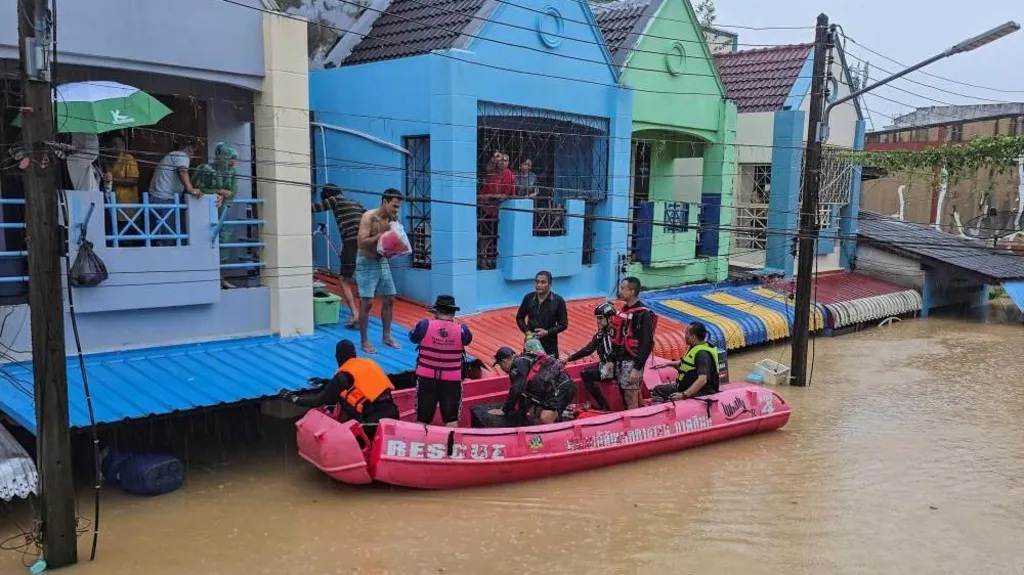Persistent rains, at times torrential, have swept across southern Thailand and northern Malaysia, displacing tens of thousands, halting transport, and prompting emergency response efforts as communities battle historic flooding.
Parts of southern Thailand are dealing with unprecedented flooding after days of relentless rain, with at least 33 people confirmed dead and thousands stranded in submerged homes. The city of Hat Yai, a key commercial hub and popular travel destination near the Malaysian border, recorded its heaviest rainfall in 300 years, with an astonishing 335mm falling in a single day. Vehicles, houses, and businesses have been submerged by rising waters, while desperate residents wait on rooftops, calling for rescue. Images circulating online show streets turned into rivers, with murky brown waters lapping at the second floors of homes.
Authorities have deployed military ships, high-clearance vehicles, and helicopters to aid stranded communities. In Songkhla province, where Hat Yai is located, the provincial government declared a disaster zone to expedite relief funding. Military planners are preparing an aircraft carrier and a flotilla of 14 boats loaded with supplies, field kitchens capable of delivering 3,000 meals per day, and medical teams that can convert the carrier into a floating hospital if necessary. Rescue teams are also using jet skis and boats to evacuate residents from heavily inundated areas.

Volunteer groups have reported being inundated with urgent calls for help. On social media, residents describe being trapped without food or clean water for days. One man reported waiting three days for assistance, noting that his phone battery was running low as the floodwaters reached his second floor. Another post showed three boys precariously hanging from power lines as the floodwaters swirled below, highlighting the desperation faced by those caught in the surge.
More than two million people in Thailand have been affected by the floods, though only a fraction have been relocated to shelters. Many remain cut off from aid, with entire neighbourhoods isolated by swollen rivers and impassable roads. The situation in Hat Yai is particularly acute, with commercial and residential districts submerged and emergency services stretched thin.

REGIONAL IMPACTS AND ONGOING RELIEF EFFORTS
The heavy rains have not been confined to Thailand. In Malaysia, more than 19,000 people have been evacuated to 126 shelters across northern border states, including Kelantan and Perlis. Rescue teams have waded through waist- and knee-deep waters to reach homes cut off by floods, bringing relief to residents and moving those at greatest risk to safe locations.
Across Southeast Asia, the flooding has been devastating. Vietnam has reported 98 deaths in just one week, with widespread property damage and agricultural losses. In Indonesia, particularly in North Sumatra, at least 19 people have died in floods and landslides, and rescue teams continue to search for at least seven others buried under debris.
The floods are being described as exceptional even for the region’s monsoon season, which typically brings heavy rainfall between October and December. Meteorologists note that this year’s storms have produced unusually high rainfall totals over short periods, intensifying river surges and overwhelming drainage infrastructure. The effects are compounded by saturated soils, which have increased the likelihood of landslides and flash flooding.
In northern Malaysia, emergency services are coordinating with local authorities to provide food, medical assistance, and temporary shelter. Residents in flood-hit areas report that access to clean water, power, and transport remains limited, and community groups have mobilized to deliver relief supplies directly to homes that remain isolated. Social media has become a critical tool for families and rescue volunteers to communicate, coordinate, and track those in need of urgent evacuation.

Authorities in Thailand continue to monitor rivers and reservoirs for rising levels, while military units maintain a visible presence across affected provinces. Coordination centres have been established to prioritise the most vulnerable populations, including children, the elderly, the sick, and those with mobility challenges. Despite the scale of the disaster, officials stress that rescue and relief efforts are ongoing, and additional resources are being mobilized from neighbouring provinces.
Experts warn that the flooding crisis may persist as heavy rainfall is expected to continue in the region for the coming days. Residents are advised to remain vigilant and follow evacuation orders where issued. Local communities are banding together, supporting each other through a combination of government aid, volunteer action, and makeshift neighbourhood rescue networks.
The floods in southern Thailand and northern Malaysia are a reminder of the vulnerability of both urban and rural communities alike to extreme weather events. While immediate rescue operations are the priority, authorities are also assessing the long-term impact on infrastructure, agriculture, and livelihoods. Restoration of homes and essential services is likely to take weeks, and recovery efforts will require extensive coordination between local governments, military units, and volunteer organizations.

As Southeast Asia grapples with these extraordinary floods, the resilience and solidarity of affected communities remain evident. Emergency services continue to work around the clock, with boats, helicopters, and relief teams prioritizing evacuations and the delivery of essential supplies. For residents stranded by the floodwaters, the coming days will be critical, with authorities emphasizing that every effort is being made to reach them safely.
Sources: Reuters, BBC, The Straits Times, CNA





















